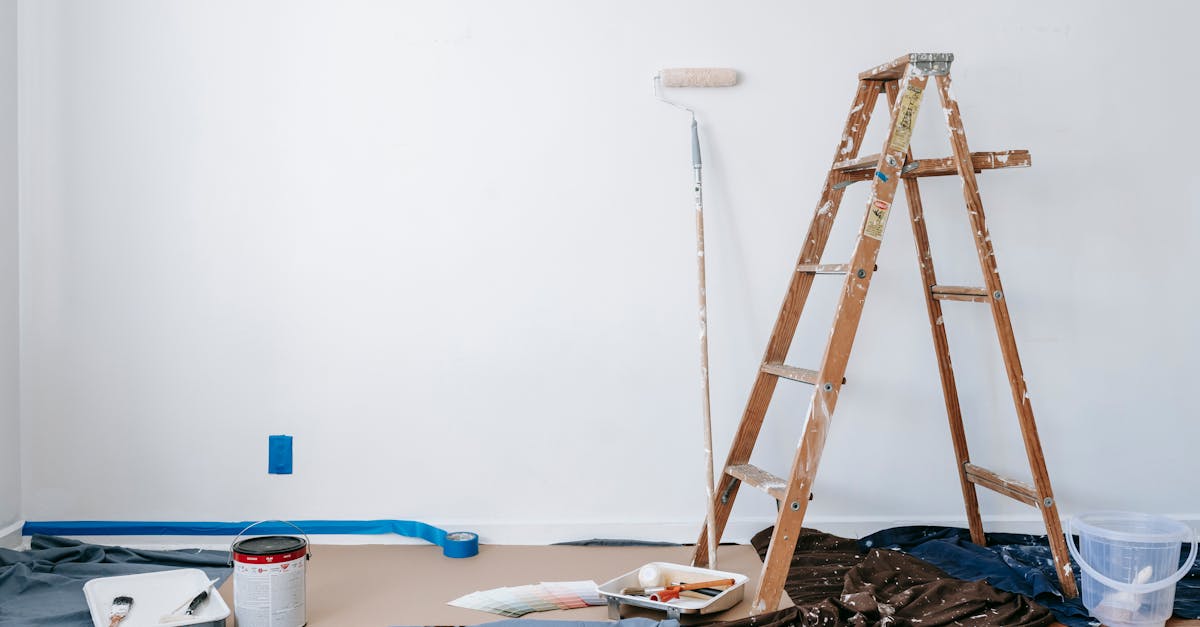This article on Choosing the Right Interior Paint serves as your ultimate guide to selecting the best options for your home. It covers essential factors such as understanding different paint bases—like latex and acrylic—and their respective characteristics. You’ll learn about paint finishes, from matte to high-gloss, and their appropriate applications in various rooms. The importance of color selection in relation to lighting and the function of each space is also emphasized. Finally, practical tips for sampling, priming, and maintaining your interior paint will be highlighted to ensure a successful painting project.
The Latest Trends in Painting and Space Renovation
In the ever-evolving world of home and commercial spaces, the right paint can dramatically transform an environment. Gone are the days of dull, uninspiring walls; today’s trends emphasize bold colors, creative techniques, and innovative materials that breathe new life into any area.
Whether you’re a homeowner looking to refresh your living room or a business owner aiming to enhance the customer experience, understanding the latest trends in interior painting can make all the difference. The choices can be overwhelming, from selecting the perfect sheen to deciding between environmentally friendly options. However, embracing these trends can lead to stunning results that not only uplift your space but also impact mood and functionality.
This article dives deep into the transformative power of color and technique, drawing on real-life projects that illustrate how effective design can create harmony and balance in any setting. Get ready to explore practical tips, popular color palettes, and expert insights that will guide you through your next painting and renovation journey.

Choosing the Right Interior Paint: Your Ultimate Guide
| Feature | Details |
|---|---|
| Finish Type | Select from matte, eggshell, satin, and gloss based on the room’s needs and lighting. |
| Base Type | Choose between acrylic, latex, and waterborne alkyd for optimal interior performance. |
| VOC Levels | Opt for low or zero-VOC paints to ensure better indoor air quality. |
| Color Selection | Consider how colors interact with natural light and the overall home design. |
| Durability | Evaluate paint durability based on the room’s traffic and activities. |
| Sample Testing | Always test paint samples on the wall to see how they look in different lights. |
| Brand Reputation | Research brands like Sherwin-Williams and Benjamin Moore for reliable quality. |
Embracing the Latest Trends in Residential and Commercial Painting
Revitalizing your space through painting can be an incredibly transformative experience. Whether you are a homeowner looking to refresh your interiors or a business owner aiming to enhance your commercial environment, the right paint choices and techniques can create atmospheres that resonate with your aesthetics and brand identity. In an industry constantly evolving with new materials and trends, it’s essential to stay informed. Below, explore key trends, colors, and practical tips that can guide your next painting project to success.
The Natural Aesthetic Trend
One of the most prominent trends in recent years is the natural aesthetic. This style embraces colors and textures inspired by nature, creating a calming and organic feel in any environment. Earthy tones such as sage greens, warm browns, and soft beiges are becoming increasingly popular, aligning with a growing movement toward sustainability and biophilic design.
An example of this trend in action can be seen in a recent residential project where a homeowner wanted to escape the city vibe. By selecting muted greens for the living room and soft browns for the kitchen, a cohesive flow was created throughout the home that reflected the surrounding natural landscape. Adding natural wood details and organic fabrics for furniture complemented this aesthetic, yielding a serene and welcoming environment.
Understanding Color Psychology
Color isn’t merely a decorative choice; it can significantly influence emotions and behaviors. The psychology of color plays a vital role in choosing the right palette.
- Blue: Often associated with tranquility, it is ideal for bedrooms or calming spaces.
- Yellow: Known for its invigorating qualities, this color boosts energy, making it perfect for kitchens and playrooms.
- Green: A color of renewal and growth, green is versatile and works well in both residential and commercial settings.
- Red: Energetic and stimulating, it can serve as a bold accent in living rooms or dining areas.
By understanding these concepts, you can tailor your color selections to align with your intended ambience. For instance, a vibrant red accent wall in a dining area can ignite conversations and appetites. In contrast, a soft blue hue in an office setting can promote focus and concentration.
Exploring Innovative Paint Techniques
Beyond color selection, innovative painting techniques offer fresh dimensions to your spaces. Two popular methods currently gaining traction are sponging and ombre.
- Sponging: This technique involves using a sponge to apply a second color over a base coat, creating texture and depth. It’s especially effective for creating a rustic or vintage look.
- Ombre: This gradient-like technique sees colors fade into one another. For example, a soft blue transitioning to a richer navy can add drama and sophistication to a living room without overwhelming it.
In one commercial project, the choice of ombre added a sense of contemporary flair to an office lobby. By fading from light to dark blue, it evoked a sense of calm and professionalism that set a welcoming tone for clients and employees alike.
Choosing the Right Paint Type
Understanding the different types of paint is crucial in ensuring your project stands the test of time. Modern paint options are more varied than ever, with latex and waterborne alkyd products leading the pack.
Latex paints are popular for their ease of application and quick drying times, making them ideal for interior walls. They come in various finishes from matte to high-gloss, allowing for versatility across different surfaces. On the other hand, waterborne alkyd paints offer a great hybrid solution, combining the best features of oil and latex paints with lower VOCs.
In a recent renovation of a commercial space, latex paint was applied in a semi-gloss finish in shared spaces due to its durability and washability. This decision was pivotal in maintaining a pristine look even in high-traffic areas.
Paint Finishes: The Subtle Yet Impactful Choice
The right paint finish can elevate your space significantly, so understanding the options available is essential. Here’s a closer look:
- Matte: This finish is perfect for hiding imperfections, making it suitable for living rooms and bedrooms.
- Eggshell: Slightly shiny, it’s easy to clean, making it popular for high-traffic areas.
- Satin: Ideal for kitchens and bathrooms, this moisture-resistant finish endures wear while remaining elegant.
- Semigloss: Often used on trim and moldings, as it stands up to scrubbing and can highlight architectural details.
In a recent residential project, a homeowner opted for eggshell paint throughout the main living areas, creating a cozy feel while ensuring easy maintenance. By combining different finishes strategically, the overall design balance was beautifully achieved.
Pairing Paint with Patterns and Textures
Gone are the days of single-color walls, as designers increasingly embrace patterns and textures. Integrating wallpaper, decals, or stencils can create dynamic features in otherwise plain areas.
In a trendy café remodel, geometric patterned wallpaper was used on one accent wall while complementary paint adorned the remaining surfaces, achieving both intrigue and harmony. Similarly, using textured wall coverings alongside vibrant paint colors can enhance the overall character of a space.
Eco-Friendly Options and Their Growing Popularity
With sustainability at the forefront of consumer preferences, eco-friendly paints are gaining traction. Low-VOC and no-VOC paints are becoming mainstream, offering options without compromising performance.
In a recent commercial project, choosing low-VOC options not only ensured a healthier environment for employees and clients but also demonstrated a commitment to sustainability, aligning with the company’s values. Utilizing eco-friendly paints can distinguish businesses in today’s conscious marketplace.
Taking the First Step Towards Your Project
If you’re considering a painting project, whether commercial or residential, it’s advisable to start with a thorough consultation. Engaging with a professional who can understand your vision and help navigate trends and choices can make all the difference. Their expertise can bring your ideas to life while also ensuring functionality and aesthetic appeal.
For those wishing to explore current trends, check out various resources and articles, such as the Wabi Sabi Painting Trend or take a look at paint colors bidding farewell to expand your palette.
Ultimately, painting can greatly influence the charm and utility of a space. By embracing trends and understanding the nuances of color and technique, property owners can create beautiful, impactful environments that truly reflect their style and purpose.

Transform Your Space Today!
Are you ready to elevate your home or business? Our expert painting and renovation services will breathe new life into your environment, creating a space that reflects your unique style. Contact us now for tailored solutions that meet your needs!
Latest Trends and Tips in Painting and Space Renovation
Trends in Painting
- Bold Colors:
Incorporating bold colors can significantly transform your space. Whether it’s an accent wall in a vibrant hue or deep tones that create a cozy atmosphere, bold colors are becoming increasingly popular in both residential and commercial spaces.
- Eco-Friendly Paints:
With a growing concern for the environment, many homeowners are choosing low- and zero-VOC paints. These options reduce harmful emissions, ensuring a healthier indoor environment.
- Textured Finishes:
Textured finishes such as sponging, rag rolling, or even using a comb can add depth and interest to walls. They are perfect for creating a unique look that stands out.
- Color Matching Services:
Advanced technology enables paint companies to offer precise color matching services, making it easier than ever to find the perfect shade to complement your furnishings and decor.
Practical Tips for Choosing Paint
- Test Paint Samples:
Before committing, always test paint samples in your space. Paint a 12-by-12 patch on the wall to see how it interacts with different lighting throughout the day.
- Understand Paint Finishes:
Recognizing the differences among finishes (matte, eggshell, satin, gloss) is crucial. For high-traffic areas, opt for glossier finishes that are easier to clean.
- Consider Room Function:
The use of the room should guide your color choices. Calming colors like blues and greens are ideal for bedrooms, while energizing yellows can enhance creativity in home offices.
- Factor in Natural Light:
The orientation and amount of natural light in your space can greatly affect how colors appear. North-facing rooms often benefit from warm tones, while south-facing rooms may thrive with cooler shades.
- Plan for Future Trends:
Stay ahead of trends and consider timeless colors that will maintain their appeal over time. Neutrals are always a safe choice for resale value.
- Interactive Paint Tools:
Utilize interactive paint selection tools available online to visualize how different colors will look in your space before making a purchase.
Frequently asked questions
Glossary of Key Terms Related to Painting and Renovation
- Interior Paint
- Paint specifically formulated for indoor surfaces, designed to resist fading and wear while providing an aesthetically pleasing finish.
- Exterior Paint
- Paint designed for outdoor use, formulated to withstand harsh weather conditions such as rain, UV rays, and fluctuations in temperature.
- Finish
- The sheen or gloss level of paint, which affects both the visual appearance and durability of the applied surface. Common finishes include matte, eggshell, satin, semi-gloss, and high-gloss.
- VOC (Volatile Organic Compounds)
- Chemicals found in some paints and coatings that can evaporate into the air, potentially causing harmful effects on health and the environment.
- Color Theory
- The study of how colors interact, including concepts like complementary colors, color harmony, and the psychological effects of different colors on mood and perception.
- Primer
- A preparatory coating applied before the main paint to improve adhesion and enhance durability while preventing stains and previous colors from bleeding through.
- Acrylic Paint
- A water-based paint known for its fast drying time and ease of cleaning with soap and water, ideal for interior applications, especially in high-moisture areas.
- Latex Paint
- A popular water-based paint choice for interiors, known for its low VOC content, ease of application, and quick drying properties.
- Accent Wall
- A single wall in a room painted a different color or pattern than the other walls, intended to create a focal point and add depth to the space.
- Contrast
- The degree of difference between colors used in a space, important for enhancing visual interest and balance within interior design.
Choosing the right interior paint is essential for transforming your home into a beautiful and inviting space. It not only enhances the overall aesthetic but also contributes to the ambiance and mood of your rooms. Understanding paint types, finishes, and the impact of lighting can empower homeowners to make informed decisions that align with their personal styles. By applying the tips and insights shared in this guide, you will have the confidence to select the best options for your home, ensuring that the colors and finishes you choose reflect your unique vision while creating a welcoming environment.
Understand Your Space
Before choosing a paint, consider the specific attributes of the room. Factors like lighting, size, and function significantly influence the colors and finishes you should select.
- Lighting: Assess natural light in the room. North-facing rooms may benefit from warmer tones to counteract cooler light.
- Size: If the room is small, opt for lighter colors to create an illusion of space.
- Function: Choose colors based on the room’s purpose. For example, calming blues are excellent for bedrooms, while energizing yellows can uplift kitchens.
Selecting Paint Types
Selecting the right paint type is crucial for achieving a flawless finish and ensuring durability.
- Acrylic vs. Latex: Acrylic paints are more moisture-resistant and suitable for humid areas like bathrooms, whereas latex is cheaper and offers exceptional coverage for general indoor applications.
- Low-VOC Options: Opt for low-VOC or zero-VOC paints to reduce harmful emissions inside your home.
- Finish Selection: Choose a finish that suits the room’s use—eggshell for living areas, semi-gloss for high-traffic areas.
Testing Before Committing
Testing paint colors before committing is crucial for a successful renovation project.
- Samples: Purchase sample cans and apply them on walls to see how they look under different lighting conditions.
- Large Swatches: Paint larger areas for a better understanding of the color’s effect on your space.
Incorporate Existing Elements
Consider your existing furniture and decor to ensure a cohesive look throughout your home.
- Accent Colors: Pull colors from your furnishings to create unity in your color scheme.
- Complements: Choose wall paint that complements fabrics, curtains, and furniture styles, enriching the overall aesthetic.
Transform Your Space Today!
Ready to breathe new life into your home or business? Our expert team specializes in premium painting and renovation services tailored to your unique vision. Experience quality craftsmanship, innovative materials, and a vibrant atmosphere that reflects your style. Contact us now for a personalized consultation and let’s create the space you’ve always dreamed of!
Mariana Pons is the visionary behind some of the most stunning transformations at TS Painting & Restoration. With a strong background in design and renovation, she has empowered countless clients in Florida to revitalize their homes and businesses with her expert painting solutions. Born in the Dominican Republic and raised in New York, Mariana seamlessly blends urban sophistication with tropical charm in her approach.
Her philosophy revolves around transformative energy. Mariana thrives on taking outdated or neglected spaces and turning them into vibrant, inviting environments. Her project portfolio is filled with compelling before-and-after stories that highlight her skill in overcoming challenges and delivering exceptional results, making her a trusted partner for clients seeking to enhance their spaces.
Outside of work, Mariana enjoys exploring new cultures through travel, indulging in culinary experiences, and staying ahead of the latest interior design trends. She believes that every project is not just a task, but an opportunity to create something extraordinary that reflects the personality and desires of her clients.
At TS Painting & Restoration, Mariana is committed to using high-quality materials and innovative techniques to ensure each painting project exceeds expectations. Her passion for color and design enables her to guide clients in selecting the perfect palettes that breathe life into their spaces, making every home and business a true reflection of individuality.


